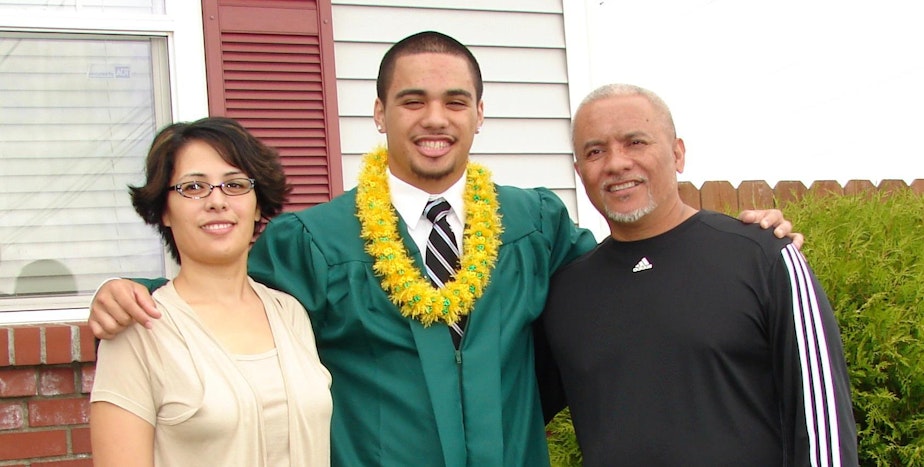Won't you be my neighbor?: Today So Far

Fear of crime is down in Seattle. Crime reports are up. And folks may be feeling more neighborly.
This post originally appeared in KUOW's Today So Far newsletter for April 26, 2022.
To the point: Fear of crime is at an all-time low in Seattle, yet reported crime is up across the city. And one factor behind all this is how close you feel to your neighbors.
That's the big takeaway from the 2021 Public Safety Survey conducted by Seattle University. It looks at local crime, and perceptions, on an annual basis.
"Overall, citywide and precinct-wide, fear of crime ratings went down, which was surprising, given people's concerns expressed about especially violent crime rising to the top concern," said Seattle University Professor Jacqueline Helfgott while chatting with KUOW's Kim Malcom.
I'm not going to try to out-explain Seattle's big brain on this story. But I am going to point to one thing that Professor Helfgott said about how the survey attempts to measure "social cohesion."
"Social cohesion measures the degree to which people know their neighbors, talk to their neighbors, rely on their neighbors. One of the interesting things about the 2021 findings is that social cohesion appears to have gone up. Research historically has shown that when people are closer to their neighbors, and when there's higher social cohesion, they're less fearful of crime. That could be a potential explanation for the lower ratings on fear of crime citywide."
Sponsored
Do you feel closer to your neighbors? I will admit that I'm not the best, most sociable neighbor. Sure, I can type away at a distance in my pajama-optional work environment. But talk to someone in-person, and convey something akin to a personality? That sounds so exhausting. But I have a feeling most of Seattle has had a different experience over the past couple years with folks working from home, taking on gardening projects, or stopping to chat on neighborhood walks. What has been your neighborly experience lately?
You can read the full survey here. In short, it has two main groups of findings. The top concerns among people who live and/or work in Seattle are: police capacity; property crime; homelessness; traffic safety; and public safety and community capacity. The top themes people spoke to were: property crime; public order crime, violent crime; public safety and community capacity; and city politics.
Be advised: This next story is going to involve sex work. But I think it speaks to that concept of a "neighbor" and the people living around us.
There's a documentary that just debuted at the Seattle International Film Festival that is prompting a local conversation. "Sweetheart Deal" follows four sex workers along Seattle's Aurora Avenue. Anyone who has driven along that stretch knows what this film is addressing. It's not like it's a big secret. But if you're like me, you just drive on by thinking, "Wow, it's really cold out, too."
KUOW's Soundside recently spoke with Dr. Shireesha Dhanireddy who works with a lot of sex workers on Aurora Avenue. She also founded the S.H.E. Clinic. This issue is complicated and spans various life situations, addiction, homelessness, and more. But Dr. Dhanireddy notes that at the core of this issue, is our neighbors.
Sponsored
"One of the things that we hear a lot is that people feel invisible," Dhanireddy said. "That being homeless robs them of that dignity of being seen and heard. And I think it's really important in our community to recognize that these are all our neighbors."
"When we think about the women on Aurora, this is your survival sex. This is exchange sex, this is sex for obtaining a place to stay, or heroin, or meth, or whatever it is that they need in that moment. It's not about making a profit. And some would say that this is not a choice."
AS SEEN ON KUOW

E.J. Strickland, dressed for graduation from Auburn High School, with his parents, Kathleen Keliikoa-Strickland and Enosa Strickland Sr. The Strickland family has filed a federal lawsuit against Auburn Police Officer Kenneth Lyman and the city of Auburn, alleging that Lyman’s negligence and unconstitutional excessive force resulted in their son’s death on May 20, 2019. The lawsuit states that since joining the Auburn Police Department in 2016, Lyman has been the subject of at least a dozen use-of-force reviews. (Courtesy of the Strickland family)
Sponsored
DID YOU KNOW?
There’s a lot of brand names we use for generic items. For example, you likely say “Hacky Sack” when you are referring to a footbag. The “Hacky Sack” brand was invented by Mike Marshall and John Stalberger in 1972 in Oregon City, Oregon. Today, it is owned by the toy company Wham-O. But they weren’t the first to come up with the idea of kicking around a bag filled with sand, beads, etc.
Footbag games, and similar games, have historically been common among cultures across the globe, particularly in parts of Asia where folks also kick around something that looks like a shuttlecock. The game of "jianzi" in China goes back to the Han Dynasty, nearly 2,000 years ago; it was used in military training. In Vietnam it is called "đá cầu." There's also Chinlone in Myanmar. And there's Basse in Norway. There are variations on the theme, but the basic idea is keeping an object from hitting the ground by only using your feet. I recommend you check out Thailand's sepak takraw which takes this concept to a volleyball court.
But in the United States, we know it as Hacky Sack. As the Hacky Sack legend goes, Stalberger was recovering from a knee injury, and Marshall introduced him to using a foot bag as exercise. Marshall said he learned about it from a Native American man while he was serving in the military (they were in the brig for going AWOL). The exercise became a popular pastime with Stalberger and Marshall, who would say they were going to “hack the sack” whenever they went to play. And the brand was born.
ALSO ON OUR MINDS
Sponsored

Biden says he will grant millions to jobs, housing for formerly incarcerated people
The Biden administration unveiled a plan Tuesday that will allocate $145 million to developing "reentry plans" for incarcerated persons, which would connect them to resources, such as jobs, housing and loans upon being released. The plan is the latest Biden initiative to tackle criminal justice reform that the president made part of his 2020 presidential campaign.

